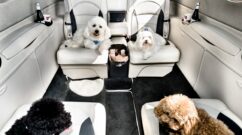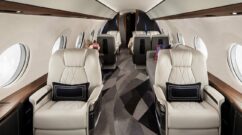Formula 1, often regarded as the pinnacle of motorsport, requires complex logistics and a tight schedule, making private jets a crucial element for teams, drivers and management. Here’s a look at the essential role that private jets play in Formula 1.
Logistics and Mobility
Frequent travel :
Formula 1 teams travel the globe, taking part in Grand Prix events in countries far and wide. With a calendar that includes more than 20 races a year, often spaced a week or two apart, the ability to travel quickly and efficiently is paramount. Private jets allow drivers and teams to travel quickly from one country to another, optimising their rest and preparation time.
Access to less accessible destinations :
Some Formula 1 circuits are located in remote areas or are less accessible by regular commercial flights. Private jets provide direct access to these destinations, reducing travel time and associated fatigue.
Comfort and productivity
Reduced fatigue :
Formula 1 drivers need to be in optimum physical and mental condition to perform at the highest level. Private jet travel offers superior comfort, reducing the fatigue and stress associated with travelling. Spacious cabins, reclining seats and personalised services contribute to better rest and optimal mental preparation.
Space to work :
For technical teams and executives, private jets offer an environment conducive to work. The aircraft are often equipped with offices, meeting rooms and advanced communication technologies, enabling teams to continue working, planning and coordinating their strategies during flights.
Flexibility and timing
Flexible hours:
Unlike commercial flights, private jets offer great flexibility in terms of scheduling. Teams can adjust their flight plans according to specific needs, ensuring that they arrive at their destination at the most opportune time to maximise efficiency.
Reduced lead times:
Embarkation and disembarkation procedures are much faster for private jets, saving valuable time. This is particularly important at race weekends, when every minute counts.
Image and Prestige
Enhanced brand image:
Formula 1 is synonymous with luxury, advanced technology and performance. Using private jets reinforces this image of prestige and sophistication. Sponsors and partners are also sensitive to this demonstration of status and success.
Concrete examples
Renom teams and drivers:
Teams such as Mercedes-AMG Petronas, Red Bull Racing and Ferrari regularly use private jets for travel. Celebrity drivers such as Lewis Hamilton, Sebastian Vettel and Max Verstappen are often seen boarding and disembarking from private jets, illustrating the importance of this mode of transport in their routine.
Equipment logistics :
As well as transporting people, private jets are sometimes used to transport crucial spare parts or technical equipment needed for races, ensuring that all the equipment arrives on time.
Private jets play an indispensable role in the world of Formula 1, offering fast mobility, unrivalled comfort and essential flexibility for teams, drivers and management. By enabling efficient travel and reducing fatigue, they make a significant contribution to on-track performance. In addition, by reinforcing the brand image and ensuring impeccable logistics, private jets are an invaluable asset in maintaining the level of excellence expected in this highly competitive sport.
Airports used for Formula 1
Formula 1, with its international calendar, requires sophisticated travel logistics. Teams, drivers and support staff need to move quickly and efficiently between different destinations around the world. Airports play a crucial role in this process. Here is an overview of the main airports used during Formula 1 Grand Prix events:
Europe
- Silverstone, United Kingdom
Nearest airport: London Luton Airport (LTN)
Oxford Airport (OXF) and Silverstone Small Aerodrome (for helicopters) are also used. - Monza, Italy
Nearest airport: Milan Malpensa airport (MXP)
Milan Linate (LIN) and Bergamo Orio al Serio (BGY) airports are also nearby. - Spa-Francorchamps, Belgium
Nearest airport: Liège airport (LGG)
Brussels airport (BRU) is another option, although further away. - Barcelona-Catalunya circuit, Spain
Nearest airport: Barcelona-El Prat airport (BCN) - Monaco Circuit, Monaco
Nearest airport: Nice Côte d’Azur airport (NCE)
Helicopters are frequently used for transfers between Nice and Monaco.
North America
- Circuit of the Americas, United States
Nearest airport: Austin-Bergstrom International Airport (AUS) - Circuit Gilles Villeneuve, Canada
Nearest airport: Montreal Pierre Elliott Trudeau International Airport (YUL)
South America
- Autódromo José Carlos Pace (Interlagos), Brazil
Nearest airport: São Paulo-Guarulhos International Airport (GRU)
Congonhas airport (CGH) is closer but mainly used for domestic flights.
Asia
- Marina Bay Street Circuit, Singapore
Nearest airport: Singapore Changi Airport (SIN) - Suzuka International Racing Course, Japan
Nearest airport: Chūbu International Airport (NGO)
Nagoya Airport (NKM) is another, albeit smaller, option.
Middle East
- Yas Marina Circuit, Abu Dhabi
Nearest airport: Abu Dhabi International Airport (AUH) - Bahrain International Circuit, Bahrain
Nearest airport : Bahrain International Airport (BAH)
Australia
- Albert Park Circuit, Australia
Nearest airport: Melbourne Airport (MEL)
Airports play a crucial role in Formula 1 logistics, allowing teams and drivers to travel quickly between race destinations. Major international airports close to the circuits are often used, offering private jet services and charter flight facilities, essential for the fast and efficient travel required by Formula 1’s tight schedule.
As experts in private aircraft charter, AEROAFFAIRES offers a VIP and personalised service at the best price. Whatever aircraft you are looking for, your dedicated flight consultant will provide you with 24/7 assistance up to 2 hours before your flight.
Nearly 95,000 passengers have already travelled with AEROAFFAIRES, on more than 20,000 different private aircraft. Travelling with AEROAFFAIRES also means supporting our Sky CO2 programme, which provides funding for the preservation of ecosystems in France.
Fill in our online quote, or contact us by telephone on +33 (0) 1 44 09 91 82 or by e-mail: charter@aeroaffaires.com.





